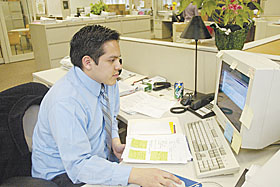Program Trains Students For Future
In Higher Ed Administration
 |
|
Jose Barzola, a graduate
student, works in the Registrar’s office as part
of the master’s degree program in higher education administration. He is
also completing a practicum in the admissions office.
|
|
Photo by Melissa Arbo |
A master’s degree program at UConn that trains students for careers in higher education administration is growing rapidly since being rejuvenated two years ago.
The master’s degree program in higher education and student affairs is a partnership between the Neag School of Education and the Division of Student Affairs. Although the program has existed at UConn for years, it declined during the 1990’s and was nearly closed after the state’s Early Retirement Incentive Program in 2003 stripped it of its last few professors.
But when Edward Iwanicki, one of the education professors who had taught a course in the program, retired, he called John Saddlemire to see if he was interested in taking it over.
Saddlemire, vice president for student affairs, and Sam Miller, associate vice president for student affairs, who had both taught in the program as adjuncts, jumped at the chance to rebuild it.
“It was either do it, or the program would go away,” says Saddlemire. “It was an easy decision.”
Now entering its second year, the revitalized program is again beginning to shine. Earlier this year, Sue Saunders was hired as the program’s full-time director, and earlier this month, dozens of potential students flocked to campus to interview for internships with a variety of UConn student affairs administrators. Students are required to secure an internship before they can be admitted to the program.
Saunders, who became program coordinator in January, previously worked in student affairs at Lycoming College and at the University of Georgia.
She says one of the factors that drew her to UConn was the unusually strong commitment from the student affairs division to partner with the Neag School of Education to make the program one of the nation’s best.
“There’s often not that commitment from student affairs,” Saunders says. “At UConn, student affairs is making a strong statement by making sure the students get an intense internship for three semesters.” The 150-hour per semester practicum lets students put into practice what they learn in the classroom.
Jose Barzola, a first-year student in the program, is enjoying it but says it is rigorous. “It’s hard juggling everything,” he says.
As an undergraduate at UConn, Barzola – a double major in Spanish/anthropology and Latino studies – served a term on the Undergraduate Student Government, worked as a mentor at the Asian American Cultural Center, devoted time to the Puerto Rican and Latin American Cultural Center, and helped out with some projects at the UConn Women’s Center.
“I really enjoyed working with other students, getting them involved in things,” he says.
So when a friend told Barzola about the program, which would put him on track for a career helping students, he jumped at the chance.
Barzola is now a graduate assistant in the Registrar’s Office, is completing a required practicum in the admissions office, and is also keeping up with his coursework. “They’re both very well-rounded jobs, and give me a good idea of what the work is like,” he says.
The practicum, required in each student’s last three semesters, is what makes UConn’s program stand out, says Saddlemire.
Richard Schwab, dean of the Neag School of Education, agrees. “The new master’s degree program includes an essential element that has helped our teacher education program become a national model – a blend of academic coursework with coordinated clinical experiences,” he says. “In a very short period of time, not only has the program attracted outstanding students, all indications are that it is gaining national prominence as well.”
A number of those students were on campus in early March, interviewing for their assistantships.
“It’s easy to tell we’re on the right track simply by the quality of the students I interviewed, and where they came from,” says M. Kevin Fahey, director of student union programming who, along with his assistant, Shontae White, interviewed 16 candidates, including a candidate from California and another from Duluth, Minn.
“As a long-time student affairs professional, I couldn’t be happier that we’re rebuilding the program,” says Fahey. “There’s a real need in student affairs for well-trained professionals.”
Indeed, according to Fast Company magazine, drawing on statistics from the Bureau of Labor Statistics, Salary.com, and a private jobs expert, higher education administrator is the 18th hottest job prospect in the nation. The demand is said to be due to continuing increases in enrollment.
Saddlemire estimates there are 15,000 people employed in the field. For a relatively small niche, that represents a lot of jobs for new graduates.
Positions include directors of cultural centers, deans of students, residential life professionals, and university presidents.
UConn’s program caps enrollment at 16, Saddlemire says, so classes – taught by education professors and full-time administrators – can be kept small, and ensure there are enough high quality internships available on campus. The two-year program requires students to work in an office related to a student function during three of the four semesters they’re enrolled, earning six credits for the work. Students are generally given research projects as well as substantive roles in offices serving students. Another 36 credits of classwork round out the program.
The students earn room and board, tuition remission, and a stipend – benefits Saddlemire describes as“well earned.”
Most importantly, says Saunders, the work the students put into the program will equip them well for a career in student affairs.
“I think our students will be coming out of Storrs with some very impressive resumes,” she says.

